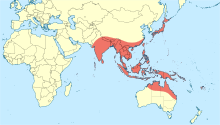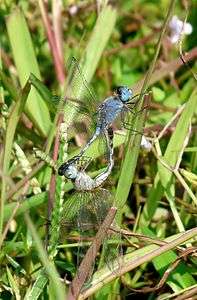Diplacodes trivialis
Diplacodes trivialis[3] is a species of dragonfly in the family Libellulidae[4] known as the chalky percher[5] or ground skimmer.[6][7] It is found in China, Japan, India and southwards to New Guinea and Australia.[8][9][10]
| Diplacodes trivialis | |
|---|---|
| Male | |
 | |
| Female | |
| Scientific classification | |
| Kingdom: | Animalia |
| Phylum: | Arthropoda |
| Class: | Insecta |
| Order: | Odonata |
| Infraorder: | Anisoptera |
| Family: | Libellulidae |
| Genus: | Diplacodes |
| Species: | D. trivialis |
| Binomial name | |
| Diplacodes trivialis | |
 | |
Description and habitat
Diplacodes trivialis is small dragonfly with bluish eyes and greenish-yellow or olivaceous thorax and abdomen with black marks. In very old adults, the whole thorax and abdomen become uniform pruinosed blue. Clear wings, without apical or basal markings, and the creamy white anal appendages and deep pruinescence in adults help to distinguish this species from others in its genus. It breeds in ponds, wet rice fields, shallow lakes, drainage ditches and similar habitats. It is one of the most common dragonflies in Asia, found in both the plains and hills and in dry and wet areas.[11][12][13][6][7]
Gallery
 Adult male
Adult male.jpg) Young male without pruinescence showing the white patch at the base of his hindwings
Young male without pruinescence showing the white patch at the base of his hindwings.jpg) Female without pruinescence
Female without pruinescence.jpg) Female with pruinescence
Female with pruinescence Mating
Mating.jpg) Female wings
Female wings.jpg) Male wings
Male wings
See also
- List of odonates of Sri Lanka
- List of odonates of India
- List of odonata of Kerala
- List of Odonata species of Australia
References
- Subramanian, K.A. (2010). "Diplacodes trivialis". IUCN Red List of Threatened Species. 2010: e.T167372A6336761. doi:10.2305/IUCN.UK.2010-4.RLTS.T167372A6336761.en.
- Rambur, Jules (1842). Histoire naturelle des insectes. Névroptères (in French). Paris: Librairie Encyclopédique de Roret. pp. 534 [115] – via Gallica.
- Martin Schorr; Dennis Paulson. "World Odonata List". University of Puget Sound. Retrieved 12 Oct 2018.
- "Species Diplacodes trivialis (Rambur, 1842)". Australian Faunal Directory. Australian Biological Resources Study. 2012. Retrieved 28 February 2017.
- Theischinger, Günther; Hawking, John (2006). The Complete Field Guide to Dragonflies of Australia. Collingwood, Victoria, Australia: CSIRO Publishing. p. 272. ISBN 978 0 64309 073 6.
- "Diplacodes trivialis Rambur, 1842". India Biodiversity Portal. Retrieved 2017-03-18.
- "Diplacodes trivialis Rambur, 1842". Odonata of India, v. 1.00. Indian Foundation for Butterflies. Retrieved 2017-03-18.
- "Facts about Diplacodes trivialis". Encyclopedia of Life. Retrieved September 13, 2012.
- Watson, J.A.L.; Theischinger, G.; Abbey, H.M. (1991). The Australian Dragonflies: A Guide to the Identification, Distributions and Habitats of Australian Odonata. Melbourne: CSIRO. p. 278. ISBN 0643051368.
- K.A., Subramanian; K.G., Emiliyamma; R., Babu; C., Radhakrishnan; S.S., Talmale (2018). Atlas of Odonata (Insecta) of the Western Ghats, India. Zoological Survey of India. pp. 322–323. ISBN 9788181714954.
- C FC Lt. Fraser (1936). The Fauna of British India, including Ceylon and Burma, Odonata Vol. III. Red Lion Court, Fleet Street, London: Taylor and Francis. pp. 336–338.
- C FC Lt. Fraser (1924). A Survey of the Odonate (Dragonfly) Fauna of Western India and Descriptions of Thirty New Species (PDF). p. 434.
- Subramanian, K. A. (2005). Dragonflies and Damselflies of Peninsular India - A Field Guide.
External links
![]()
![]()
